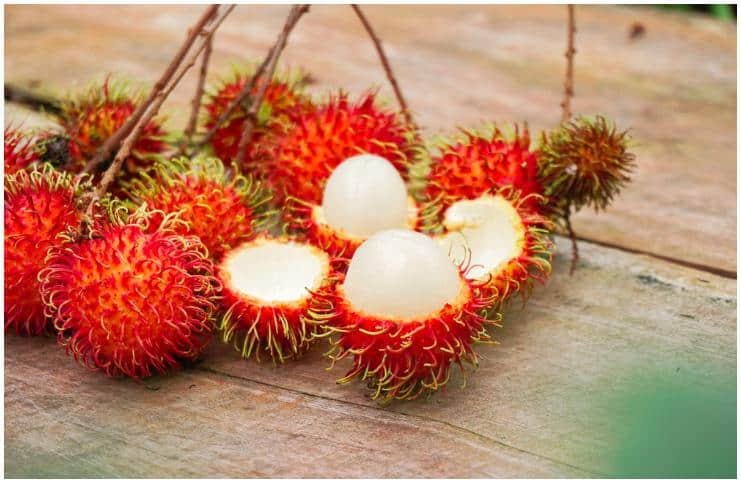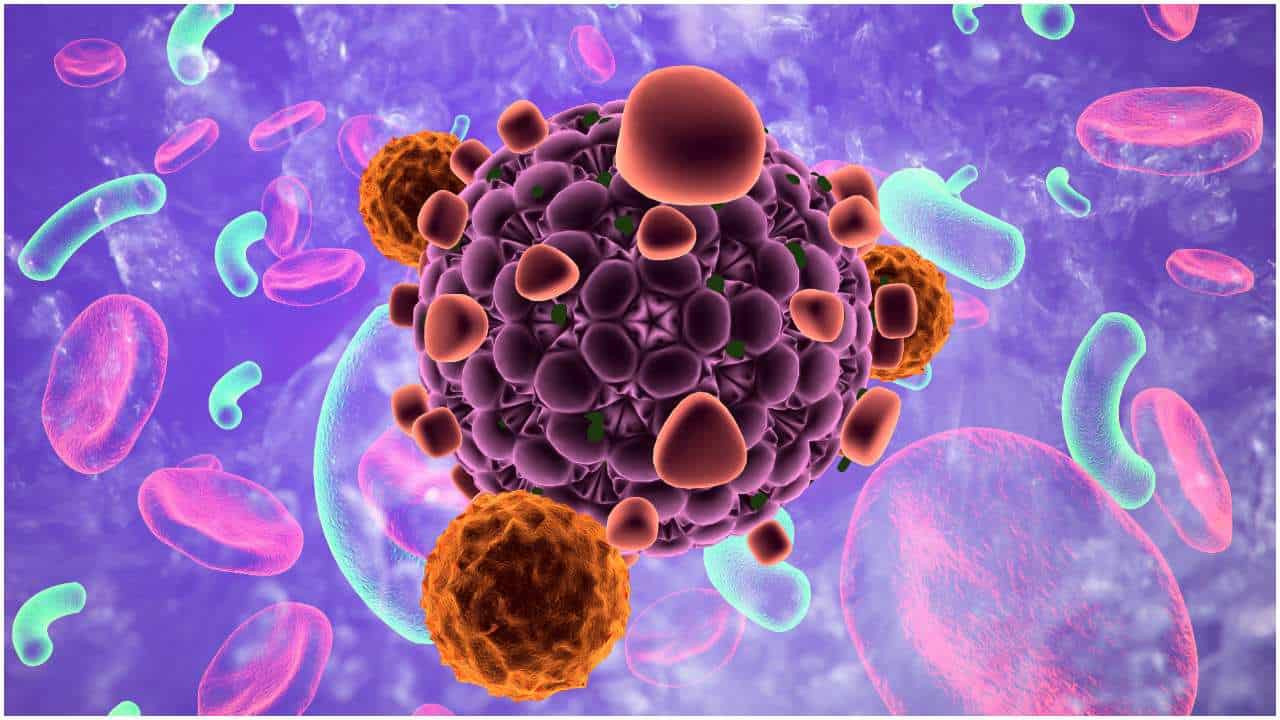Top 10 Rambutan Fruit Benefits And Its Taste & Precautions:
Rambutan (botanical name – Nephelium lappaceum), also known as chôm chôm, meaning “messy hair,” is a type of fruit that looks much akin to the lychee with a sweet/sour flavor.
The rambutan tree, similar to other tropical trees that bear fruits like the mamoncillo, lychee, and longan, is native to the Malay-Indonesian region, and other regions of tropical Southeast Asia.
It is now widely grown in Vietnam, India, Phillippine, Sri Lanka, Burma, and Thailand, followed by Hawaii and Australia.
The tree belongs to the family Sapindaceae (soapberry) and grows to about 10-20 feet in height. It thrives in climates with high rainfall and humidity.
What Does The Fruit Taste Like?
It is a small, red round colored fruit with spiky hair on the skin. Most fruits are juicy and sweet, but some varieties are slightly drier or acidic.
The interior flesh is white to pale pink with a flavor similar to grapes. Good and tasty rambutans are supposed to be red (the more vivid red, the better).
Are the seeds edible?
The seed in the center is not edible while raw, but it may be eaten after cooking.
Nutritional Facts
This fruit offers many health benefits as it has rich amounts of natural sugars, minerals – such as iron, phosphorus, calcium, zinc, potassium, copper, manganese, and magnesium, vitamins A, B3, Vitamin C (100g serving of rambutan will equate to 40% of the daily recommended intake) and vitamin B9 (folate).
The seeds contain equal proportions of unsaturated and saturated fatty acids, like oleic (42 percent) and arachidic (34 percent) acids.
Health Benefits of Rambutan Fruit
Anti-Inflammatory Properties
This fruit contains gallic acid, which is an organic acid with potent anti-inflammatory properties, according to a 2006 study published in the journal “Toxicological Sciences.”
Gallic acid can be used as a remote astringent, as it works to stop bleeding and constrict tissues. It is also found in sumac, gallnuts, witch hazel, watercress, and oak bark.
Cancer Prevention
A 2014 study at the Universiti Kebangsaan Malaysia on ”Antioxidant and Antiproliferative Activities of Non-Edible Parts of Selected Tropical Fruits” concluded that this fruit can be effective against cancer (1).
In addition, the active compound in this fruit – gallic acid – acts as a potent antioxidant that helps eliminate free radicals damage from the body and prevent cancer.
Lowers Blood Pressure Naturally
Hypertension is occasionally called the silent killer because it produces no symptoms. Over time, hypertension causes blood vessel damage that can lead to kidney disease, heart disease, stroke, and other serious problems.
Also, being obese or overweight increases your risk of developing high blood pressure. This fruit is low in calories and saturated fat, hence perfect for people with hypertension.
Good During Pregnancy
During pregnancy, the heart works harder in order to provide adequate nutrients to the fetus. Due to this increase in blood volume, it is essential for pregnant women to also increase their intake of iron.
Actually, you need about twice the amount of iron – 27 mg daily – than you do when you’re not pregnant. Combine this fruit (during the day) with morel mushrooms, parsley, dried apricots, sun-dried chilies, and spinach for ideal iron levels.
Antioxidant Properties
Antioxidants work by enhancing the body’s defenses against potentially dangerous compounds called free radicals. Free radicals can be created from cigarette smoke, pollution such as smog, toxins, as well as our good friend the sun.
In addition to the antioxidants within the fruit, the skin of the fruit has numerous types of antioxidants that can be boiled and the water ingested to fully enjoy these health benefits.
Furthermore, a 2010 study at Chiang Mai University in Thailand established that the pulp, seeds, and skin have strong polyphenolic compounds called flavonoids (2). Flavonoids are mainly known as pigments for flower coloration, producing red/blue or yellow pigmentation in the plants.
Healthy Bones
Manganese is essential for the normal growth of the human bone structure since manganese helps with the formation of bone regulatory enzymes and hormones involved in bone metabolism.
Also, low levels of this mineral can act as a trigger for epileptic seizures.
100g of this fruit contains 15 percent manganese of the recommended daily intake.
Boosts Immunity
Immunity is an important benefit of vitamin C, which is widely known for its contribution to the immune system of the body and its stimulation of white blood vessels.
Many studies found that vitamin C may help protect against different cancers by helping neutralize the effects of nitrites and combating free radicals (3).
100g of this fruit contains 5 percent vitamin C of the recommended daily intake.
Provides energy
Carbs provide the body with energy immediately. Your body breaks down carbs for immediate fuel. That’s their purpose by nature and depriving yourself of them will leave you fatigued and tired all day long.
Consuming this fruit is ideal after physical exercise when your aim should be to replenish the carbohydrates you burn off during physical exercise.
100g of this fruit contains 16 percent carbs of the recommended daily intake.
Prevents Heart Disease
A low intake of folate (also known as vitamin B9 which is different from its synthesized from – acid folic) increases your risk for high homocysteine levels and cardiovascular disease, which ultimately may also lead to Parkinson’s disease.
Moreover, folate can maintain healthy blood circulation. Some studies suggest that vitamin B9 may play an important role in the fight against cancer (4).
100g of this fruit contains 2 percent folate of the recommended daily intake.
Lowers LDL Cholesterol and Triglycerides
One of the most effective and least expensive methods to lower blood lipids (triglycerides and cholesterol) is to consume niacin-rich foods daily.
As with all of the B vitamins, niacin (vitamin B3) helps convert food into energy by helping enzymes do their job. Severe niacin deficiency, or pellagra, occurs when diets are not varied.
100g of this fruit contains 8 percent vitamin B3 of the recommended daily intake.
Selection and Storing
Select a fruit that is firm when touched gently. Also, it should not be peeled until just before it is served. The spines have to be firm and not brittle to touch.
It can be stored at room temperature for a few days. In addition, to preserve a few days longer, wrap the fruit in a breathable plastic bag and refrigerate.
How To Eat
You can easily peel open the fruit by splitting the skin apart with your nails (or a knife) and spreading it back, much as you would peel an orange. Hold the fruit and nibble off the succulent flesh discarding the seed.
Rambutan vs Lychee
Despite their similarities (both have white flesh, flavor, a big seed in the middle, and grow on trees), these fruits are quite different in terms of nutritional profiles and taste.
Originating in China, lychee (sometimes spelled litchi) is a tropical fruit known for its fragrant and sweet flavor.
Additionally, in structure, the fruit is oval, heart-shaped, or nearly round, weighs about 10 g, and measures about 3 cm in diameter and 3–5 cm long. It is a small fruit packed with healthy nutrients. In appearance, lychee has close resemblances with rambutan and longan fruits.
Side Effects
There are no known side effects of consuming this fruit. However, when the fruit is too ripe, sugar will turn into alcohol which will raise LDL cholesterol levels in the body and be dangerous for some people suffering from hypertension (high blood pressure) and type 2 Diabetes Mellitus.
Moreover, the seeds are mildly poisonous if eaten raw, but they can be eaten without any adverse effects if they are cooked.




Rambutan are one of my favorite tropical fruits. But lately I refrain from eating because I observed some fresh blood stain in my stool after me and my wife consumed almost 2kg in a day . Please comment about this. Thank you